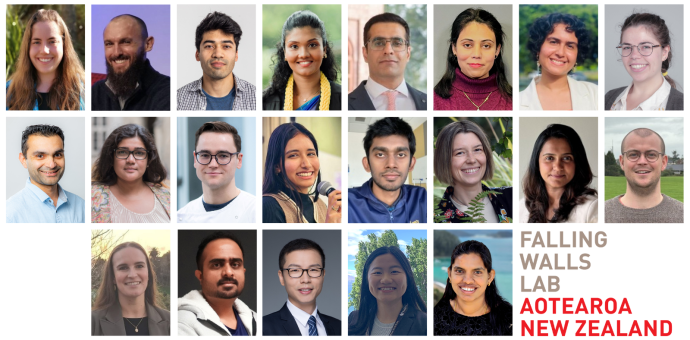News
Published 17 July 2025Announcing the 2025 Falling Walls Lab Aotearoa New Zealand event

Twenty-one participants from around Aotearoa New Zealand and the Pacific Island Nations will pitch their innovative breakthrough ideas at the Falling Walls Lab Aotearoa New Zealand event on Thursday 7 August.
Coming from as far away as Fiji, participants will have the opportunity to showcase their innovative research, scientific idea, or evidence-based initiative, and how it could make a difference for society in a three-minute presentation.
The winning pitch will have the chance to represent the region and compete at the Falling Walls Lab Global Finale in Berlin.
View 2025 Falling Walls Lab Aotearoa New Zealand programme to learn more about the event and the participants:
This year’s participants and their topics for Falling Walls Lab Aotearoa New Zealand are:
1. Priyanshi Negi, Division of Management, University of Waikato
Breaking the Wall of Unsustainable Dairy
Dairy and many milk alternatives strain land, water and lower emissions targets. I aim to break this wall by creating a zero-land, climate-positive milk from upcycled food waste and air-derived proteins. This solution cuts food waste, reduces greenhouse gases, and offers a sustainable, nutritious alternative—bridging food security and planetary health without relying on traditional farming.
2. Xinya Wang, Riddet Institute, Massey University
Breaking the Wall of Calcium Deficiency
Calcium deficiency is widespread across countries and genders. While fortified foods aim to increase intake through added calcium salts, the role of food structure in calcium release remains unclear. We developed a dynamic in vitro digestion model (oral, gastric, intestinal) to investigate calcium release from various food matrices and identify structure-dependent pathways for efficient calcium delivery and absorption.
3. Lizhao Zhu, University of Waikato
Breaking the Wall of Disability Isolation
In New Zealand, disabled individuals face accessibility barriers in daily tasks like dining, cleaning or shopping, limiting their independence. Meanwhile, young people in the community are willing to help but lack a platform to receive nearby requests promptly. This disconnect hinders efficient support, leaving disabled individuals underserved, volunteers underutilised, and impacting community cohesion and quality of life for those with disabilities.
4. Manochitra Loganathan, Unitec Institute of Technology
Breaking the Wall of Bias in AI
We aim to make AI systems fair and inclusive for historically-disadvantaged communities. Currently, many AI models reflect and reinforce historical discrimination, leading to biased outcomes in areas like healthcare, employment and justice. These patterns are often embedded in data and algorithms. We are developing an automated tool to detect and reduce such bias in real-world AI decision-making.
5. Cervantée Wild, The University of Auckland
Breaking the Wall of Land-bound Health Systems
I seek to break the wall of land-bound healthcare in Aotearoa. When severe weather cuts off communities, health services often disappear. Our systems are built for land, not for water. I propose a fleet of mobile health boats delivering essential child health services to coastal and island communities, ensuring no child is left without care.
6. Upulanka Premasiri, Human Interface Technology Lab New Zealand, University of Canterbury
Breaking the Wall of Discomfort in VR
We investigate how combining voice commands, touch, gaze, controllers, and hand gestures can reduce physical and mental fatigue in extended VR use. These input methods enable multimodal interaction techniques, offering greater flexibility. By facilitating more comfortable interactions, we aim to unlock the full potential of VR across various domains, such as training, rehabilitation, education and many more.
7. Sam Collins, University of Waikato
Breaking the Wall of Profit-Driven Gambling
Gambling ought to be a sustainable hobby. I argue that the industry’s for-profit business model incentivises predatory business practices that exacerbate wealth inequality. With global gambling company Entain entering the New Zealand market, I argue this unequal distribution of wealth is now being extracted off-shore – eroding the ecosystem and our economy; and guaranteeing neglect of the socioeconomic issues that unsustainable gambling practices spawn.
8. Sachini Weerasinghe, Massey University
Breaking the Wall of Setting Carbon Budgets
Carbon budgets are established to measure progress toward achieving climate targets outlined in international policies. However, current budget allocation methods overlook temporal dynamics affecting emissions. Our approach integrates prospective dynamics to estimate future emissions at national or sectoral levels and allocates carbon budgets dynamically. It supports more flexible and timely formulation of policy measures for effective national and sectoral decarbonisation strategies.
9. Jacqueline Theis, University of Otago
Breaking the Wall of Nature for All
I’m breaking the wall between cities and nature with the New Zealand Biodiversity Factor (NZBF), a tool that helps urban professionals design more biodiverse spaces. It provides scores and tailored recommendations for residential, commercial, and transport projects. The NZBF translates ecological knowledge into action by embedding biodiversity into urban planning for the benefit of both people and native wildlife.
10. Kavishan Ranatunga, The University of Auckland
Breaking the Wall of Carbon-Intensive Concrete
We seek to reduce the carbon footprint of concrete, which contributes about 8% of global greenhouse gas emissions, by replacing cement with volcanic materials. Unlike other countries, New Zealand lacks industrial by-products for cement replacement. Our research focuses on using volcanic materials to make low-carbon and durable concrete for more sustainable infrastructure.
11. Matthew Howes, The New Zealand Institute for Public Health and Forensic Science
Breaking the Wall of Safer Cannabinoid Drugs
Wairuakohu (Radula marginata), a taonga species from Aotearoa, produces unique cannabinoid-like compounds that may be safer alternatives to those derived from the cannabis plant. Wairuakohu-derived cannabinoids have potential as add-on therapies to treat conditions like epilepsy and multiple sclerosis. Using cutting-edge liver-on-a-chip models, we are investigating their toxicity and interactions with other drugs.
12. Indira Venkatraman, University of Canterbury
Breaking the Wall of Coastal Climate Risks
This study seeks to create wellbeing portfolios for rural coastal lowland adaptation options. For this purpose, social, economic, environmental, and cultural wellbeing in coastal systems are looked at from a community perspective. These wellbeing portfolios are also studied under the lenses of accounting and accountability.
13. Ankit Parikh, Auckland University of Technology / Exsurgo Ltd
Breaking the Wall of Chronic Pain
Chronic pain affects around 30% of the global population. It impacts health, mood and quality of life. It costs billions in healthcare and loss of productivity. Current treatments, like surgeries and medications, offer limited relief. Opioids pose major risks. We are developing much-needed non-drug-based alternatives. We have tested our prototype system in a clinical feasibility trial with promising results.
14. Ellie Johnson, He Kāinga Oranga, University of Otago, Wellington
Breaking the Wall of Housing-Related Illness
Every year in New Zealand, an estimated 229 people die because of poor-quality housing. Cold, mouldy, and damp homes—widespread across the country—contribute to a significant burden of disease. Disease that is preventable. In response, the Healthy Homes Initiative was developed: a housing intervention programme aimed at improving housing conditions to improve the health of children at risk.
15. Catherine Mahima Singh, The University of the South Pacific
Breaking the Wall of Legal Inaccessibility
I aim to break the wall of legal inaccessibility by proposing an AI-powered legal aid system for marginalised communities. This innovation would simplify legal processes, offer multilingual and disability-friendly support, and connect users to real legal help. While still conceptual, it highlights how technology can transform justice into a right accessible to all - not just the privileged.
16. Asma Khan, Lincoln University
Breaking the Wall of Symbolic Green Financing
I am breaking the wall of green finance failure by exposing how self-interests and greenwashing raise monitoring costs and weaken true environmental outcomes. My research demonstrates how various ecological regulations and governance structures can mitigate these inefficiencies, helping policymakers create credible green finance systems that support genuine sustainability rather than allowing firms to exploit green funding for false claims.
17. Zarar Rasheed, Robinson Research Institute, Victoria University of Wellington
Breaking the Wall of Hydrogen Storage
Hydrogen fuel stations store gas at extremely high pressures, posing serious safety concerns. TiFe alloys offer a safer, solid-state hydrogen storage alternative but are expensive to produce. We are breaking this wall by creating TiFe alloys sustainably from ilmenite mineral sands, making hydrogen refuelling safer, more affordable, and accessible for the green energy transition.
18. Mindula Irugalbandara, Auckland Bioengineering Institute, The University of Auckland
Breaking the Wall of Gut Contractions
I seek to break the wall of gut motility disorders by improving our understanding of how gut contractions relate to the underlying electrical activity that drives them. While the gut bioelectrical signals are well-studied, contraction patterns remain poorly characterised. I’m developing a framework to quantify these patterns and link them with electrical activity, enabling targeted approaches to improve gut health.
19. William Allouche, University of Waikato
Breaking the Wall of Circular (De)Construction
We research a novel construction method that enables repair and end-of-life reuse and recycling of a building’s structural components. To address a buildings’ significant construction and demolition waste, recyclable composite materials are introduced as novel building materials. Combined with design optimisation algorithms and 3D printing, a design workflow is explored to streamline building design for (de)construction and waste minimisation.
20. Erica Sue-Tang, Lincoln Agritech Ltd
Breaking the Wall of Biodegradable Bioplastics
Common petroleum-based plastics aren’t renewably sourced or biodegradable, and millions of tons end up in the environment, creating cancer-causing microplastics. Bioplastics are made from renewable resources but very few are biodegradable. For example, PLA is a common bioplastic, but it contributes to microplastic pollution. My idea is a cellulose bioplastic made using renewable resources that biodegrades into sugars in natural environments.
21. Patrick Mazzocco, University of Otago
Breaking the Wall of Career Centrality
Career development practices and modern societal norms encourage existential tethering to one’s career. That is, the more meaning and purpose one has in their career, the more fulfilled and successful they will be. This study challenges that ideology, proposing that career breaks, instead of being perceived as undesirable interruptions, might be integral to 21st-century career development and lifelong learning.
The winners will be selected by the Falling Walls Lab Aotearoa New Zealand jury:
- Professor Phil Lester, Insect Ecology, School of Biological Sciences, Victoria University of Wellington (Jury Chair)
- Professor Riz Firestone, Senior Research Officer, Centre for Public Health Research, Massey University
- Veronika Meduna, New Zealand Editor for The Conversation
- Professor Volker Nock, 2019 Rutherford Discovery Fellow, University of Canterbury
- Winnie Switakowski, Deputy Head of Mission at the German Embassy in Wellington
Media and members of the public are invited to register to attend the event
More about Falling Walls Lab
Falling Walls Lab events are held in numerous countries worldwide. The winners of these Lab competitions are automatically admitted to the Falling Walls Lab Finale in Germany in November each year where they will again pitch their idea to a jury of distinguished academics and businesspeople.
The Falling Walls Foundation is a non-profit organisation in Berlin, dedicated to the support of science and the humanities. It was established in 2009, 20 years after the fall of the Berlin Wall. At its heart is the question ‘Which are the next walls to fall?’ because of scientific, technological, economic, and sociological breakthroughs.
Visit https://www.falling-walls.com/lab
